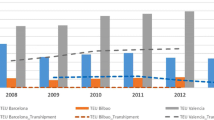Abstract
The growth in intermodal transport has led to an increase in competition between ports. Other factors, such as the globalisation of the economy, European Union interest in integrating the port system into the Transeuropean Transport Network and the reform of the Spanish port system, have encouraged the Spanish Port Authorities to develop competitive strategies to extend their hinterlands. These strategies have often focused on improving port infrastructure in order to improve the efficiency of their services. In this paper, we analyse the extent to which investment expenditure has led to improvements in efficiency and how far this improved efficiency has increased the port's ability to attract traffic. To do so, we use DEA and study inter-port traffic redistribution from the land side. The analysis focused on the Ports of Bilbao and Valencia not only because they are very important in the Spanish port system but also because they both stand out for their investment expenditure, which has led to quite different results. We conclude by discussing the consequences of investment and port location for efficiency and the capacity to attract traffic, respectively.
Similar content being viewed by others
Notes
Arocena and Rodríguez (1998) apply the Malmquist sequence production index in terms of output to the Spanish electricity sector under the assumption of technology with constant returns and point out that it may be able to solve problems of small samples.
Verifying the homogeny meant that contingency tables had to be drawn up for the interport distribution of maritime traffic for each one of the 47 Spanish peninsular provinces. The rows of these tables showed the years and the columns showed the ports. Each ton of merchandise sent to each port from the corresponding province in each one of the years analysed was considered to be one event.
We considered that the port selection of a province was ordinally stable for a particular port when the corresponding value of λ was below 0.15. For provinces in which we observed stability in order of ranking for the Ports of Bilbao or Valencia, or both, we conducted a χ2 homogeneity test to evaluate the null hypothesis of independence between port selection and year of selection, and so check whether strength of preference was maintained. Provinces were classified as stable or ordinally stable according to whether they passed or failed this test. The other provinces, classified as ordinally unstable, were those for whom one of the two ports studied, or both, were always in the top three for that province but whose ranking changed beyond the limit established for considering the province stable.
References
Arocena, P and Rodríguez, L . 1998: Incentivos en la regulación del sector eléctrico español. Revista de Economía Aplicada VI: 61–84.
Banker, RD, Charnes, A and Cooper, WW . 1984: Some models for estimating technical and scale inefficiencies in data envelopment analysis. Management Science 30: 1078–1092.
Bergantino, AS . 2002: The European commission approach to port policy: Some open issues. International Journal of Transport Economics XXIX: 337–379.
Charnes, A, Cooper, WW and Rhodes, E . 1978: Measuring the efficiency of decision making units. European Journal of Operational Research 2: 429–444.
Dirección General de Puertos y Costas. Several years: Memoria de actividades de Puertos. Ministerio de Obras Públicas y Transportes: Madrid.
Ente Público Puertos del Estado. Several years: Anuario Estadístico. Ministerio de Fomento, Madrid.
Ente Público Puertos del Estado. Several years: Informe de Gestión. Ministerio de Fomento, Madrid.
Färe, R and Lovell, CAK . 1978: Measuring the technical efficiency of production. Journal of Economic Theory 19: 150–162.
Farrell, M . 1957: The measurement of productive efficiency. Journal of the Royal Statistic Society – Series A II: 252–267.
Garcia-Alonso, L . 2005: Competencia interportuaria: delimitación y análisis del área de influencia de los puertos españoles. Doctoral Thesis, University of Oviedo.
Goss, RO . 1990: Economic policies and seaports: 4. Strategies for port authorities. Maritime Policy and Management 17: 257–271.
Haralambides, HE . 2002: Competition, excess capacity, and the pricing of port infrastructure. International Journal of Maritime Economics 4: 323–347.
Haralambides, HE, Verbeke, A, Musso, E and Benacchio, M . 2001: Port financing and pricing in the European Union: Theory, politics and reality. International Journal of Maritime Economics (IJME) III: 368–386.
Martin-Bofarull, M . 2002: El sistema portuario español: regulación, entorno competitivo y resultados. Una aplicación del análisis envolvente de datos. Doctoral Thesis, University of Rovira i Virgili.
Notteboom, TE . 2006: The time factor in liner shipping services. International Journal of Maritime Economics 8: 19–39.
Park, RK and De, P . 2004: An alternative approach to efficiency measurement of seaports. Maritime Economics and Logistics 6: 53–69.
Pestana Barros, C and Athanassiou, M . 2004: Efficiency in European seaports with DEA: Evidence from Greece and Portugal. Maritime Economics and Logistics 6: 122–140.
Ríos, LR and Gastaud, AC . 2006: Analysing the relative efficiency of container terminals of Mercosur using DEA. Maritime Economics and Logistics 8: 331–346.
Robinson, R . 2006: Port-oriented landside logistics in Australian ports: A strategic framework. Maritime Economics and Logistics 8: 40–59.
Shephard, RW . 1970: The Theory of Cost and Production Functions. Princeton University Press: Princeton.
Siegel, S and Castellan, NJ . 1988: Nonparametric Statistics for the Behavioral Sciences. McGraw-Hill, New York.
Ugboma, C, Ugboma, O and Ogwude, I . 2006: An analytic Hierarchy Process (AHP) approach to port selection decisions-empirical evidence from Nigerian Ports. Maritime Economics and Logistics 8: 251–266.
Author information
Authors and Affiliations
Rights and permissions
About this article
Cite this article
Garcia-Alonso, L., Martin-Bofarull, M. Impact of Port Investment on Efficiency and Capacity to Attract Traffic in Spain: Bilbao versus Valencia. Marit Econ Logist 9, 254–267 (2007). https://doi.org/10.1057/palgrave.mel.9100183
Published:
Issue Date:
DOI: https://doi.org/10.1057/palgrave.mel.9100183




